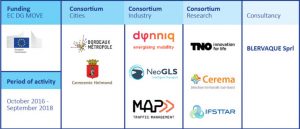About
Introduction
C-The Difference pilot project has been elaborated on the basis of a shared vision developed and adopted by the consortium partners representing demand and supply sides who have been committed for the last 10 years to bring C-ITS ( Cooperative-Intelligent Transport Systems) to the market through intensive efforts and long lasting investments in the development and deployment of C-ITS services. This group of pioneers are strong believers in the capacity of C-ITS services to bring efficient and cost-effective solutions to address urban mobility problems with respect to traffic efficiency, safety and impact on the environment.
Success in implementation and long run provision of C-ITS services rely on five golden rules that need to be addressed in a coordinated and integrated way:
Inter-operability
Sustainability
Scalability
Replicability
Reliability
Objectives
- Deliver comprehensive and integrated impact assessment by means of enhanced evaluation methodology and up to 18 months operation of C-ITS services package
- Bridge the gap between most advanced C-ITS implementations in urban environment and large scale deployment and operations by targeting professionals responsible for urban transport planning and operations, policy makers and decision makers
- Convince European cities to invest in mature and proven C-ITS solutions by fostering and replication through City Twinning Program
Consortium

Funding
EC DG MOVE – tender MOVE/C3/2015-544 Pilot project « Beyond traffic jams: intelligent integrated transport solutions for road infrastructure »
 English
English  Français
Français 